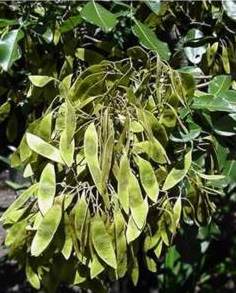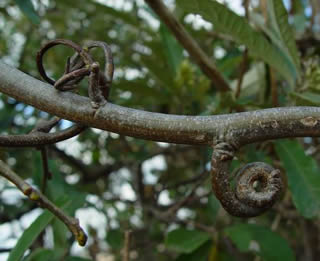Dalbergia obovata
Dalbergia obovata E.Mey.
Family: Fabaceae
Common names: climbing flat bean (Eng.); bobbejaankoudoring, rankplatboontjie (Afr.); udukuduku, isibandhlube, uphandlazi (Zulu); umzungu, umzungulu (Xhosa)
Introduction
Dalbergia obovata is an unusual robust shrub or climber with attractively dense clusters of sweet-smelling flowers followed by pretty yellow-green pods

Description
Description
Dalbergia obovata is a canopy climber, up to 30 m in the wild, or in cultivation it can be a small tree, 2-6 m, with a spreading crown and a main stem that is attractively crooked and branching low down.

It occurs mainly as a much-branched, scandent shrub or robust climber that puts out long branches with "hooks" that it uses to cling to surrounding vegetation. The handsome, compound leaves have large glossy leaflets, which are dark green above and blue-green below, with wavy margins, and are borne in a slightly zigzagged pattern. The leaf stalk has velvety brown hairs covering it.
Small, pretty creamy white to yellowish white flowers are sweetly scented and are produced in profusion in large dense bunches in spring (October to November) followed by clusters of flat, oblong pods in summer (February to April) which are very attractively two-toned yellow with green where the bump of the seed is, bearing one to two seeds which are visible through the pod walls.

Distribution and habitat
Distribution description
This species favours coastal and riverine forest and forest margins as well as wooded slopes, and deciduous woodland. It is widespread in the former Transkei and KwaZulu-Natal, and is found from the Eastern Cape to southern Mozambique.
Derivation of name and historical aspects
History
Named in honour of the Swedish brothers Nils and Carl Dalberg, the former a botanist and royal physician, and the latter who owned an estate in Surinam from where he sent specimens to Linnaeus.
One of the Zulu names of this species is uDukuduku and it is from this that Dukuduku, one of the largest forests in KwaZulu-Natal, takes its name.
Dalbergia is a genus of about 100 species of trees, shrubs and climbers. D. obovata grows from Tanzania, southwards through Mozambique, Gauteng and KwaZulu-Natal to the Eastern Cape.
Dalbergia flowers have the notable distinction of being amongst the oldest of all known flowers, because their fossils have been discovered in Cretaceous rocks that are about 92 million years old.
The Fabaceae is the second largest flowering plant family. It contains more than 600 genera and 12 000 species and is found throughout the world. In southern Africa this family is represented by 134 genera and more than 1 300 species.
Ecology
Ecology
Modified, tendril-like branches enable the plant to support itself on surrounding vegetation, sometimes completely smothering and killing these supporting plants.

Beetles and a wide variety of insects are attracted to the flowers. The leaves are heavily browsed by game and stock. Dassies (hyrax) in particular, are very fond of eating them. Birds are also attracted to the plant for food.
Ecologically, legumes are well known for fixing nitrogen in the soil through a symbiotic relationship with bacteria. The bacteria infect the roots, forming small growths or nodules. Inside the nodules, atmospheric nitrogen, which the plants cannot use, is converted to ammonia, which plants can use. The plant supplies sugars for the bacteria, while the bacteria provide the biologically useful nitrogen that the plant absorbs.
Uses
Use
Zulus use the roots as an ingredient in love charm emetics; a paste of charred and powdered stems mixed with water is used for sore mouths in infants; ash from the plant is used in snuff; and a twine rope is made from the bark.
The very attractive timber is heavy and red and the Zulus use it to make sticks and stools from the wood. The stems of the plant are used by the Tongas in Maputuland to form the framework of their fishing baskets, and woven hut walls.
Growing Dalbergia obovata
Grow
For cultivation this plant would be suited to most climates, wet or dry, warm or temperate; it will also withstand some frost. It is hardy and tolerant of most garden conditions. It can be briefly deciduous.
Dalbergia obovata is not a striking plant, but it is showy when in flower and in seed, making it an interesting garden subject.
It will grow in the full sun but will also do well in semi-shade conditions and will tolerate full shade; remember that in full sun it will produce more flowers. It does best in fertile, well-drained soil with plenty of water in summer, but is tolerant of summer drought. It is very easy to grow, extremely fast-growing and flowers when young, To keep it under control, shaped and more floriferous, prune lightly after flowering.
It has quite dense foliage and so can be used as a dense impenetrable hedge, or for screening; it will grow very well along a fence (it is self-supporting) or used in a mixed screen. In time, and left to its own devices, it can form an interestingly shaped focal point. Grow it as the backdrop for an herbaceous border, or use it as part of a bush clump.

It is easily raised from seed sown in spring or early summer and takes from 3 to 6 weeks to germinate. Soaking in hand-hot water and treating with a fungicide that combats pre-and post-emergence damping off, although not essential for germination, will increase the number of successful seedlings. Prick out soon after the first pair of true leaves have developed, taking care not to damage the taproot. Protect young plants from frost. They will flower in the 2nd or 3rd year. These plants may also be propagated by means of cuttings.
References
- Gibson, J. 1975. Wild flowers of Natal (coastal region). Natal Flora Publications Trust, Durban.
- Hutchings, A. 1996. Zulu medicinal plants: an inventory. University of Natal Press, Pietermaritzburg.
- Leistner, O.A. (ed.). 2000. Seeds plants of southern Africa : families and genera. Strelitzia 10. National Botanical Institute, Pretoria.
- Pooley, E. 1993. The complete field guide to trees of Natal, Zululand and Transkei. Natal Flora Publications Trust, Durban.
- Ross, J.H. 1980. Dalbergia obovata. The Flowering Plants of Africa 46: t. 1818.
- Van Wyk, B-E. & Gericke, N. 2000. People's plants. A guide to useful plants of southern Africa. Briza Publications, Pretoria.
Credits
Cherise Viljoen
Kirstenbosch
December 2006
Plant Attributes:
Plant Type: Climber, Scrambler, Shrub
SA Distribution: Eastern Cape, KwaZulu-Natal, Limpopo
Soil type: Sandy, Clay, Loam
Flowering season: Spring
PH: Neutral
Flower colour: White, Cream, Yellow
Aspect: Full Sun, Shade, Morning Sun (Semi Shade), Afternoon Sun (Semi Shade)
Gardening skill: Easy
Special Features:
Horticultural zones










Rate this article
Article well written and informative
Rate this plant
Is this an interesting plant?
Login to add your Comment
Back to topNot registered yet? Click here to register.